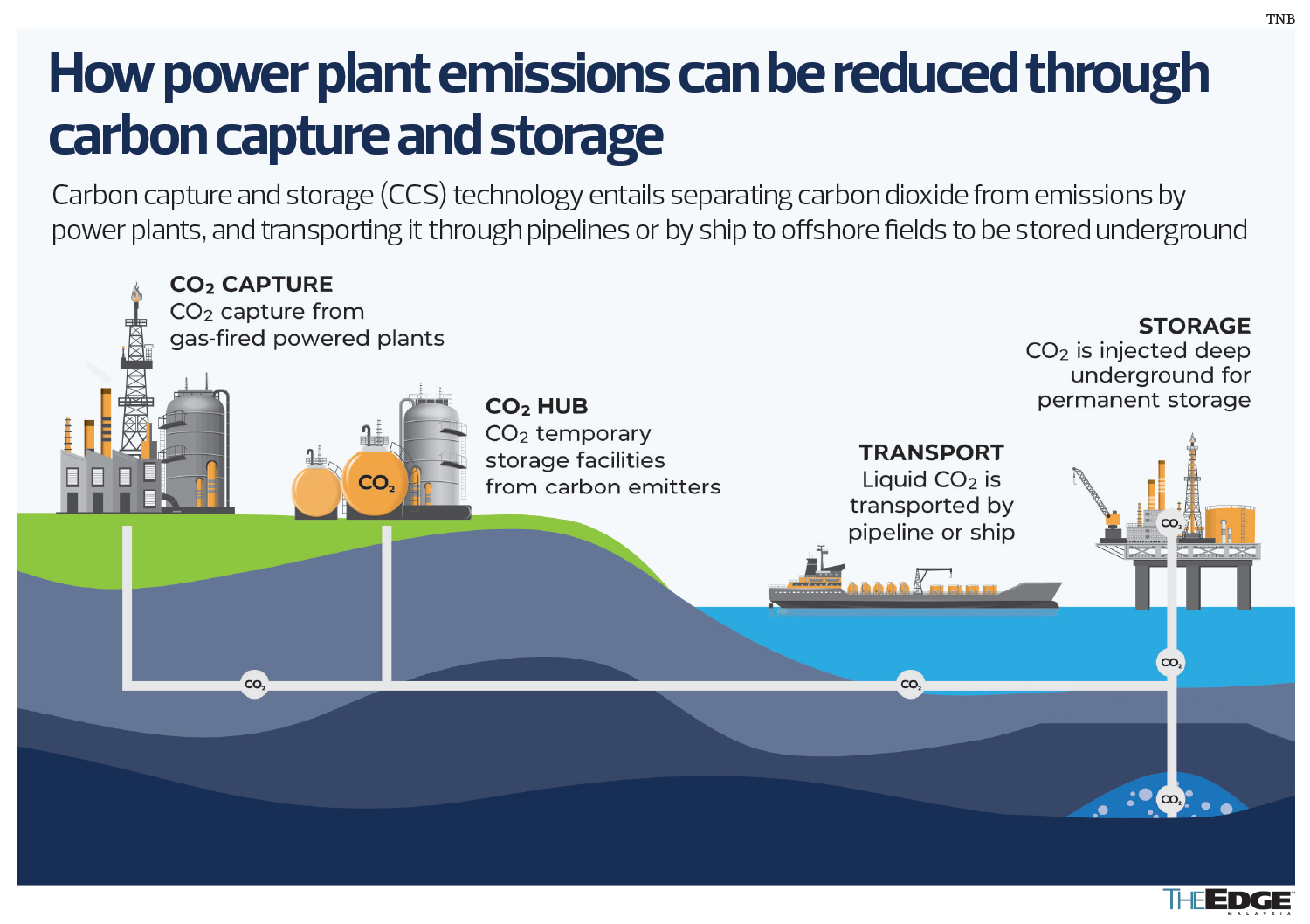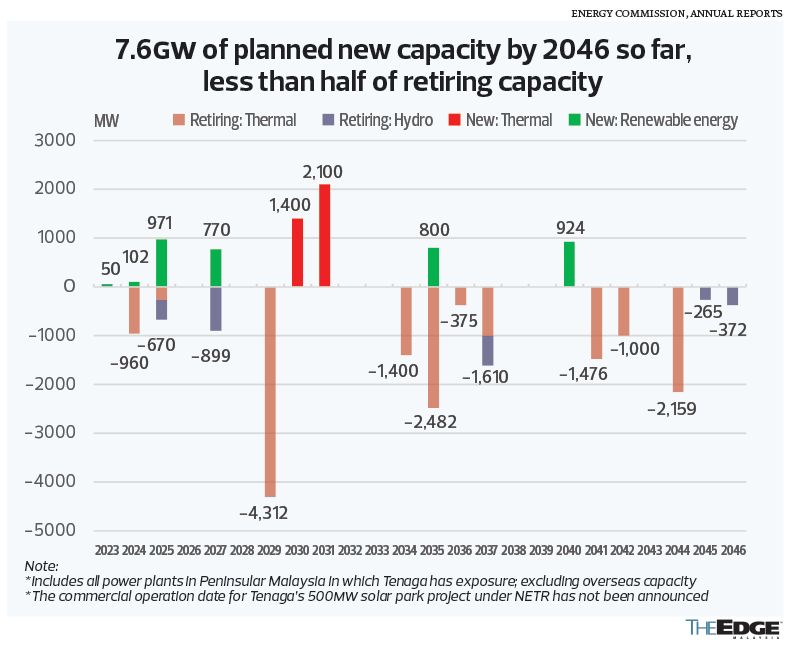
This article first appeared in The Edge Malaysia Weekly on November 27, 2023 - December 3, 2023
THE one key task, which is also a tough challenge, that Tenaga Nasional Bhd CEO Datuk Seri Baharin Din’s predecessors did not have to face is addressing the utility group’s greenhouse gas emissions.
Like many energy companies globally, including its peer Petroliam Nasional Bhd (Petronas), Tenaga is in the race for new technologies and solutions that can reduce its carbon emissions.
In August, Tenaga and Petronas signed a definitive agreement to conduct feasibility studies on green hydrogen as well as carbon capture and storage (CCS) technologies. It is a partnership that was unforeseen as the two local giants are usually in opposing positions when it comes to gas supply.
For them to finally firmly join hands shows the extent of the changes faced by the energy industry as a result of the global net zero carbon emissions agenda.
One of Tenaga’s hurdles in presenting itself as a “changed” entity for the net zero landscape is its substantial exposure to coal-fired power generation capacity, which forms more than 40% of its capacity mix.
This exposure, which was once strategic for Malaysia because coal was a cheap source of energy, has become a burden for Tenaga which has two decades before its last long-term coal-fired power purchase agreement expires in August 2044.
That same exposure has put a drag on Tenaga’s group-wide valuation and the reason the spin-off of its generation arm, TNB Power Generation Sdn Bhd (Genco), may not happen soon as it needs to “decarbonise” Genco’s operations first.
At the same time, Tenaga has set an ambitious renewable energy (RE) capacity target of 7,000mw by 2030 and committed to reducing half of its coal generation capacity by 2035.
Asked about the listing of Tenaga’s power generation arm, Baharin says: “Genco’s initial public offering is still under consideration as we analyse the various scenarios in optimising our generation decarbonisation plan.
“Anything that will give best value to Tenaga, we will definitely not ignore. This is something that we see as an opportunity rather than a liability.”
Baharin, an electrical engineer by training, believes the way forward is to address the group’s emissions through technology that includes CCS, hydrogen and ammonia for electricity generation.
“We think we can address carbon dioxide (CO2) through technology,” he says. “I always say coal is not the culprit. It is the CO2. Address the CO2, not the coal … It’s a question of viability, which will come over time.”
In a nutshell, CCS entails capturing carbon emissions from power plants and temporarily storing them on-site before cooling them down to liquid form and transporting this to offshore fields to be injected underground.
The group is working closely with Petronas “to determine the economic cost, what’s the ‘cut-off’ or the sweet spot for hydrogen or CCS to become viable”, Baharin says. He adds that it will take at least a year to conclude the feasibility studies.
The relationship makes sense as Tenaga can tap Petronas’ expertise to extract its emissions to be injected underground.
Tenaga, which produces 61% of Malaysia’s electricity, has sizeable generation assets that could help kick-start Petronas’ sale of green hydrogen and potentially ammonia in the domestic market.
Tenaga has 9,680mw of coal generation capacity in its portfolio, which generated 27% of the RM32.44 billion revenue plus imbalance cost pass-through (ICPT) under recovery in 1H2023.
This is followed by 7,332mw of gas, and 5,198mw of RE generation capacity. It also has another 350mw in coal generation capacity under construction by a minority-owned entity, according to its annual report.
Based on equity ownership, Tenaga’s share of generation capacity amounted to 16,374mw, of which just 3,761mw, or 22.5%, is RE-based.
The clock is ticking
With the pipeline for coal-fired power plants retiring starting from 2029 and no other newbuild of such power plants, Tenaga is betting on hydrogen and ammonia as a low carbon energy source to replace the sizeable power generation from coal.
Ammonia is a component made of hydrogen and nitrogen and is usually used for fertilisers.
While the success will help to fill in the gaps from RE as the country works towards net-zero emission by 2050, the commercial viability and contribution to earnings from hydrogen and ammonia technology are still unknown globally.
Today, RE generation, which is mainly from solar, is still not reliable to power an economy, and power plants that are fuelled by coal or gas are the main sources to fill in the gaps.
Over the next 15 years, Tenaga will see the retirement of 12,708mw of generation capacity in the country. Just 52% (6,193mw) of that will be replenished, based on the existing pipeline of projects.
Of the new capacity, 2,693mw will be from RE, including the upcoming 300mw Nenggiri hydro dam project due in 2027, as well as the 500mw solar park and 2,500mw hybrid hydro-solar systems under the NETR in stages across the timeline.
To ensure energy security and maintain its top line, Tenaga has recommended to repower the plants that are retiring before 2030 with natural gas, which is said to be a more sustainable source alternative to coal with an added hydrogen co-firing capability. It also has recommended a new low-carbon, gas-powered combined cycle gas turbine (CCGT) plant with hydrogen co-firing ready as replacement for the coal power plant that will retire in 2029.
Tenaga is currently working on a feasibility study of coal plants to co-firing with ammonia, biomass for Jimah East Power (JEP) (2,000mw), Kapar Energy Ventures (KEV) (2,200mw) and Janamanjung (4,080mw) in collaboration with Petronas, Mitsui & Co and Chugoku.
In October 2022, Genco received a letter of intent (LOI) from the government, which granted approval in principle for the development of a greenfield 2,100mw CCGT plant, together with Widad Business Group Sdn Bhd, to be situated north of the existing coal power plant. The CCGT plant commercial operation date is slated for 2031.
Tenaga has also received another LOI from the government to repower and retire the 1,400mw Paka gas-fuelled power plant with the intent to make it hydrogen-ready by 2030.
The power purchase agreement for the current Kapar facility, a 2,200mw gas and coal-fired power plant owned by Tenaga and Malakoff Corp Bhd in a 60:40 joint venture, expires in June 2029. Its gas power plant in Paka, the 1,400mw Sultan Ismail Power Station, was decommissioned in December 2019.
“You cannot just retire these [coal-fired power] plants because that will affect the reliability and security of supply. The [other] strategy to decarbonise is to reduce [dispatch less] or swap [existing capacity with new RE capacity],” Baharin says when asked about his views on retiring coal plants for ESG-compliance purposes.
“You can reduce with the introduction of technology such as CCS, co-firing plants with hydrogen, ammonia and so on. The other is retiring or you can dispatch less [from coal-fired plants] but not retire totally.
“While you are doing that, you can also do a parallel move [swap] by building up RE.”
In September, the government said it is looking at launching a request for proposal for early retirement of coal plants, and also the option of “mothballing” them, namely bringing them out of operations but available for future use when energy is needed.
Baharin points out that the early retirement of the coal-fired plants will be costly for the country. Instead, these power plants could fill the gap and ensure a steady supply as Malaysia builds up its RE capacity.
Part of Tenaga’s RE portfolio is held overseas. In the UK, it will have 102mw of solar capacity to come online next year, bringing its total to 632mw.
The UK arm, Vantage RE, saw Ebitda (earnings before interest, taxes, depreciation and amortisation) jump 42.5% year on year to £64.4 million (RM379.4 million) in 1HFY2023, from £45.2 million in 1HFY2022, owing to higher prices secured and additional contribution from its wind generation portfolio.
Nonetheless, there is the issue of cost and viability of the co-firing projects, as prices of ammonia are still far higher than coal and gas, while the price of green hydrogen is still at least double that of oil on a per barrel basis.
In September 2022, research agency BloombergNEF estimated that a coal plant with 50% ammonia co-firing would cost at least US$136/mwh in 2030, and that it will still emit more carbon dioxide than a natural gas-powered combined-cycle gas turbine power plant.
The International Energy Agency’s (IEA) 2050 roadmap calls for 306 million tonnes (MT) of green hydrogen to be produced each year, which it notes will require annual investment in pipelines and hydrogen-enabling infrastructure to increase from US$1 billion (RM4.68 billion) today to US$40 billion by 2030.
It will be an expensive endeavour, as investments into green technology such as hydrogen and CCS “will run into a few billion ringgit”, says Baharin. “If you want to reduce the CO2, you need to spend. As the technology matures, however, costs will come down.”
Through these projects, Tenaga estimates that it will reduce emissions intensity by 35% and halve its coal generation capacity by 2035, from base year FY2020.
Save by subscribing to us for your print and/or digital copy.
P/S: The Edge is also available on Apple's App Store and Android's Google Play.


